新闻
Hôtel de charme, dans Paris centre
Rue Saint-Honoré is a very old street, the continuation of a Roman road. It owes its present name to a chapel dedicated to Honoré d'Amiens, built between 1204 and 1209, and wish no longer exist.

The Saint-Honoré church appears on the Turgot plan of 1739. It was destroyed after the French Revolution in 1792.
We have a 17th-century document showing the Palais Cardinal, as it was built by Cardinal Richelieu. The building appears to have changed little in appearance, and is located 500 meters away from the Relais Saint-Honoré. Today, it is called the Palais Royal and is shown in the engraving, on the side of the Conseil d'État, in the central foreground. The Opera House can be seen at the far end. It was Molière's theater, which burned down in 1763 and again in 1771.


Fire at the Opéra on April 6, 1763. It was rebuilt in 1770, but burned again on June 8, 1771
Let's fast-forward a few more years, to 1795. We're 50 meters from the Relais Saint-Honoré. A Royalist rebellion was crushed on October 5, 1795 in front of the church of Saint Roch. The buildings depicted on this anonymous engraving still exist today.

We are now in 1865, on the corner of rue Saint-Honoré and rue de la Ferronnerie. The site has been completely transformed by the construction of the Rue des Halles and the Rue du Pont-Neuf in 1866.

Rue Saint-Honoré, rue de la Ferronnerie – Charles Marville – 1865

Photo by Charles Marville circa 1868 - Musée Carnavalet
Three years later, in May 1871, major events would turn the city upside down: the Commune insurection. Let's move on to rue Saint-Honoré from rue Castiglione. The insurectionnists of the Paris Commune erected barricades to protect the Place Vendôme from the charge of the Versaillais (regular army). Repression by the army was severe.

Let's program our time machine again and go to 1888, near the Louvre. We see a building that still exists today. It houses a department store that has now disappeared: Les Grands Magasins du Louvre.

The origins of the Grands magasins du Louvre date back to 1855. It claimed to be the world's largest department store. It closed its doors for good in 1971. Part of the site will soon be occupied by the Fondation Cartier, which is relocating its museum to Boulevard Raspail.
We can now move on to 251 rue Saint-Honoré. It was the Nouveau Cirque address from 1886 to 1926. The innovative concept was an arena that could be transformed into a swimming pool in just a few minutes. The building was demolished. Today, the Mandarin Oriental Palace occupies this address.

The new circus, left foreground, ca. 1890-1900
Let's move towards our time. We're in 1908, at 95 rue Saint-Honoré, in front of a facade that still exists: A la renommée des Herbes cuites. It's one of the most beautiful old façades in Paris. Its first floor is occupied by the restaurant Le bistrot du 1er, which is well worth a visit.

Au Bourdon d'Or – Eugène Atget 1908
Let's continue our journey. At the end of August 1944, in the final days of the liberation of Paris, a many individuals, including both civilians and other armed members of the Forces françaises intérieures, were watching machine-gun firing exercises. The demonstration took place in the Rue Saint-Honoré, transformed into a barricade for the occasion.

And we end at Number 308, rue Saint-Honoré. This 17th-century building was rented to Jean de La Fontaine from 1672 to 1793 by Madame de La Sablière. La Fontaine's Fables are considered one of the masterpieces of French literature. This building is the Relais Saint-Honoré.


Chocolates

From bottom to top and left to right:
- Rocher Praliné almond and hazelnut, nougatine chips: Slightly salted, very fragrant. Very rich in cocoa and pralines. The nougatine adds a festive touch. It's generous, though not overly sweet, which is quite impressive considering the ingredients. Nice texture.

- Manon: Foaming caramel, milk chocolate and fleur de sel ganache. Very rich in caramel. Very delicate and melting.
- Yuzu: Dark chocolate and yuzu ganache. The fruit, and perhaps even the variety of cocoa used, adds a slight touch of acidity, contrasting with the dark chocolate. Very fine.
- Carbonado: Almond and hazelnut praline, nougatine. This chocolate is quite incredible. There's a hint of foie gras. It's very rich, with two praline components plus a nougatine. It cracks in the mouth!
- Néo: between raspberry and chocolate. Very feminine.
- Yaoundé: Grand cru ganache from Cameroon. The cocoa is truly magnificent. Roasted coffee flavors.
- The marron glacé, although a candied fruit, is not too sweet. It's slightly vanilla and the chestnut is very present. It melts in the mouth.
Pastries
- The chocolate éclair (on the right in the photo) revealed a very powerful, long-lasting cocoa, although we would have preferred a lighter filling. It's just a question of taste.
- We preferred the Praliné Feuilleté. It's a very structured cake. It's rich, nutty and delicious. Recommended for children!
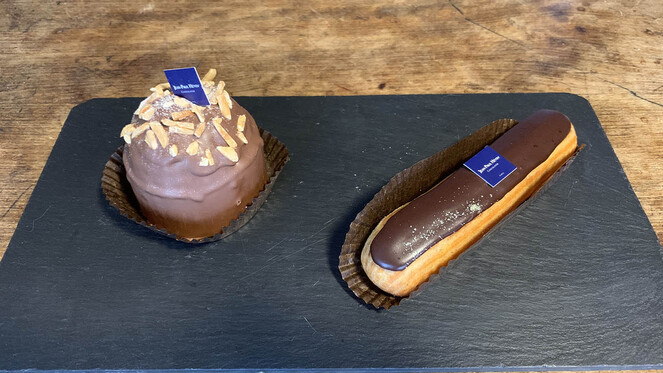

Then we have two meringue cakes:
- Princesse pistache: A cake as pretty to look at than to eat. The pistachio is discreet, which tells us that the flavor is not artificial. It's a meringue cake filled with marzipan and nougatine. It's very festive and children will love it!
- Longchamp praliné: This is an almond dacquoise with a meringue center, coated in milk chocolate and almonds. Delicious.


In short, we enjoyed the finesse of the cocoa, the uninhibited generosity of a pastry from our childhood, and the quality of the craftsmanship. Jean-Paul Hévin is one of Paris's great pâtissiers and chocolatiers, and a must-try.
Jean-Paul Hévin
108 Rue Saint-Honoré – 75001 Paris
https://www.jeanpaulhevin.com/nos-boutiques?ville=paris&boutique=louvre
Tuesday to Saturday, 10:00 a.m. to 7:30 p.m.
The Louvre is currently presenting two exceptional temporary exhibitions, which we visited: "Naples à Paris" and "Le trésor de Notre-Dame de Paris". A look at these exhibitions.
"Naples à Paris"
For the year 2023, the Louvre Museum has entered into an unprecedented partnership with the prestigious Capodimonte Museum in Naples.Capodimonte is one of the few museums on the peninsula whose collections enable us to present all the schools of Italian painting. The exhibition features some 70 works by some of the greatest names in Italian painting, including Titian, Caravaggio and Michelangelo.
The works are presented in the Paris museum's permanent collections. The two sets of Italian paintings from the 15th to 17th centuries are among the most important in the world.

Altarpiece of Saint Vincent Ferrier - Colantonio, 1456-1458

Saint Jerome in his study - Colantonio - 1445-1450
Jerome of Stridon (Saint Jerome 347-420), is said to have encountered a lion wounded by a thorn in the paw, who let him nurse it back to health. The legend goes on to say that the lion became Jerome's pet.

The Flagellation - Caravaggio, 1607

Charles de Bourbon's departure for Spain - Antonio Joli, 1759. On becoming King of Spain, Charles de Bourbon ceded the kingdoms of Naples and Sicily to his son in 1759.
"Le Trésor de Notre Dame de Paris"
The exhibition features liturgical objects, relics, manuscripts and precious objects donated out of devotion. The collection traces a thousand-year history, from its medieval origins to its 19th-century renaissance under the impetus of Viollet-le-Duc.
The diversity of the treasure is on display in over 120 works. It includes rare manuscripts and artistic representations, as the original liturgical silverware was destroyed during the Revolution of 1789. The First Empire period saw the reconstruction of the treasure, with the addition of notable relics including the Crown of Thorns and the Wood of the Cross.
The exhibition also explores the treasure's earlier history, dating back to Merovingian times. The exhibition is based on inventories, historical accounts, works of art and historical documents. It offers a glimpse of this vanished wealth, comparable to the objects created for Notre-Dame in the 19th century.

Gregory of Tours' History of the Franks, a parchment manuscript completed in 591, is a highly valuable historical document.
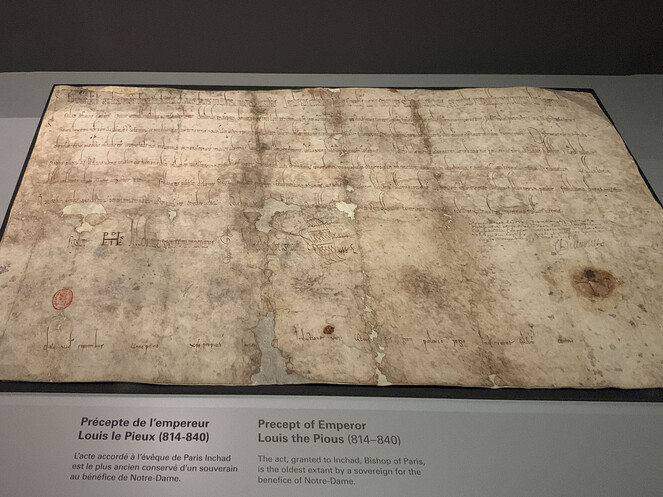
The precept of Louis the Pious, son of Charlemagne, is a legal document made up of ordinances and laws.

Here you'll find the objects used at the coronation of Napoleon 1st, all of which can be seen in David's painting "The Coronation of Napoleon 1st" (below).

.

Reliquary of the Crown of Thorns acquired by Saint Louis in 1238. Reliquary designed by Viollet-Le-Duc, 1879
Musée du Louvre
Wednesday to Monday, 9am to 6pm. Closes at 9.45pm on Fridays
Due to overcrowding, we recommend that you visit at lunchtime or on Friday night. Choose the Carrousel du Louvre entrance (99 Rue de Rivoli, 75001 Paris).
« Le Trésor de Notre-Dame de Paris » until January 29, 2024: https://www.louvre.fr/en-ce-moment/expositions/le-tresor-de-notre-dame-de-paris
"Naples à Paris" to January 8, 2024: https://www.louvre.fr/en-ce-moment/expositions/naples-a-paris
https://www.louvre.fr/

Modigliani in Paris

Paul Guillaume, left, and Amedeo Modigliani in Nice in 1917
Modigliani's gallery owner
Paul Guillaume became Modigliani's gallery owner in 1915. The painter and the dealer frequented the artistic and literary circles of Paris, and shared common tastes. Paul Guillaume encouraged Modigliani, tried to make him known and to sell his paintings. He continued to promote his protégé even as Modigliani met another major dealer.
All the works presented in this exhibition have a close connection with Paul Guillaume. Around a hundred paintings have passed through his hands, as well as a dozen sculptures and some fifty drawings.

Modigliani's influences and confluences

Head of a Woman - Marble - Circa 19013
The early 20th century was marked by a growing interest among Western artists in primitive art, whose values and forms were considered original. Modigliani's classical education in Florence and Venice was overturned when, in 1908, he discovered ancient Egyptian reliefs and archaic Greek statuettes in the Louvre, Ivory Coast masks and Angkor temple fragments in the Musée du Trocadéro.

Lola de Valence - 1915
When Paul Guillaume opened his gallery in 1914, he simultaneously exhibited African sculptures and modern paintings. At the same time, Modigliani frequented the Musée d'Ethnographie du Trocadéro, demonstrating his interest in the art it conveyed.
The signature Modigliani
Modigliani's subjects often seem to express solitude, unless the artist deliberately wished to depersonalize his models, as if to mask them.

Young girl with striped blouse – 1917
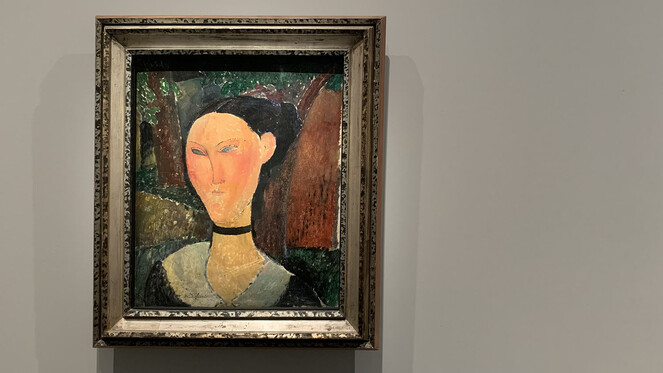
Young brown girl seated – 1918

Young brown girl seated – 1918
Interacting with art
The Musée de l'Orangerie invites young and old alike to interact with a range of equipment made available to visitors.


The exhibition is a unique opportunity to discover or rediscover the works of one of the most influential artists of the 20th century. It's also a look at one of the most fruitful artistic relationships of the early 20th century. A must-see!
Musée de l’Orangerie
Wednesday to Sunday, 9:00 am to 6:00 pm - Nocturne until 9:00 pm on Fridays
https://www.musee-orangerie.fr/fr/agenda/expositions/amedeo-modigliani-un-peintre-et-son-marchand
We recently tried the restaurant Le Lazzy for you.

Among our favorite spots is the café "Le Square"

The perspectives offered by Haussmann's architecture are breathtaking, and the atmosphere here is reminiscent of Milan

The perspectives offered by Haussmann's architecture are breathtaking, and the atmosphere here is reminiscent of Milan
We had the opportunity to truy for you the Théâtre Edouard VII's Italian restaurant, owned by Régis Campana. This Italian with a passion for exquisite flavors is hospitable and kind.

Le Lazzy reminds of the elegance of Milan's chic restaurants. Its magnificent setting, charming and peaceful, is home to one of the most beautiful terraces in Paris
The restaurant also offers two indoor dining rooms as weel as the elegant and charming terrace. What attached us was the quality of the furniture and the presentation of the tables of the terrace. Outdoor rattan chairs, marble-topped tables, cloth napkins and Degrenne cutlery all contribute to the chic look.

A €29 lunch offers a choice between starter-main course or main course-dessert. We chose the latter and decide to share the starter and dessert. To go with our meal, we order a glass of rosé.
We opened our meal with grilled and marinated vegetables, tastefully presented on a charming Provencal-style plate. Eggplant, zucchini, carrots, spring onions and sesame seeds are sublimated by quality olive oil.

We then enjoyed homemade Fusilli with cream, topped with pine nuts, Parmesan and pistachio pesto. The generous, flavorful sauce won us over, and we didn't hesitate to sauce it until the end of the dish.

We also enjoyed a filet of grilled sea bream with a lemon butter, spring onion and parsley sauce, served with a jardiniere of grilled vegetables. A very pleasant summer dish.

We enjoyed a vanilla and passion fruit panna cotta that was as delicious as it was refreshing.

In conclusion, lunch or dinner on the terrace of Le Lazzy is an excellent choice during the summer months, if you're looking for both peace and refinement in the dishes on offer and the magnificent setting.

Lazzi
10 place Édouard VII, 75009 Paris
12:00 to 14:30 and 19:00 to 23:00 Tuesday to Friday
7:00 pm to 11:00 pm on Saturday and 12:00 pm to 5:00 pm on Monday.
https://lazzi.fr/fr/
See the menu:
ttps://lazzi.fr/mdgFront/uploads/homeblockdownload/1/carte.lazzi.printemps.pdf
It's a place for those who love books, of course, and not just in French. It's also a place for lovers of beautiful architecture and culture in general. Readers and visitors of all ages and nationalities can consult the 20,000 available books, including France's largest freely-accessible collection of comics - 9,000 volumes in a variety of languages. The Richelieu Library has two reading rooms, including the famous Salle Ovale.

Since its creation as a royal library, it has preserved treasures from the kings of France, enriched over the centuries.
The Bnf Richelieu, as it is known to the French, also presents two high-quality temporary exhibitions a year.
Major renovation work was completed in September 2022, making this exceptional place even more dazzling.
Museum history
The building is a conglomeration of plots acquired by Cardinal Mazarin from 1635 until 1649, when he had two galleries built by François Mansart, followed by a private mansion. These lots were gradually broken up, then reunited in 1722, when the ensemble became the royal library. Numerous transformations and extensions have been carried out since then.
The Royal Library is shown on the Turgot plan (1734-1739)
Salle Ovale and Salle Labrouste

The Oval Room


Book on Japanese prints, in German (Taschen)

Les Misérables by Victor Hugo, 1930 edition in Vietnamese. The Richelieu Library collaborates with 250 foreign libraries

Salle Labrouste

Salle Labrouste in 1888 photographed by Louis-Émile Durandelle
The museum's permanent collections

Entrance hall with staircase by Bruno Gaudin You'll have to climb the handsome staircase in the hall to see the museum's permanent collections, which feature some 900 rare items such as Dagobert's throne, Charlemagne's chessboard (13 pieces dating from the 11th century) and a rare photograph by Arthur RimBaud.

Étienne Carjat's 1871 portrait of Arthur Rimbaud is one of the few existing photos of the poet.

Throne of Dagobert (King of the Franks 602-639). Listed by the Abbot of the Basilica of Saint-Denis in the mid-12th century, who claims to have had it repaired.

Aurillac bracelet - 3rd century BC Found in Aurillac (France), this is one of the rare Gaulish gold bracelets

The Galerie Mazarin, a vestige of the Palais de Mazarin, is the only example of a Baroque gallery
 The two volumes of the original manuscript of Victor Hugo's Les Misérables, now restored, are on display in the Mazarin gallery
The two volumes of the original manuscript of Victor Hugo's Les Misérables, now restored, are on display in the Mazarin gallery
Temporary exhibitions
The "Degas in Black and White" exhibition features works in pencil, watercolors, pastels, etchings and photographs. Everything is an opportunity for Degas to create atmospheres full of contrasts. At the end of his life, Degas even said: "If I had to redo my life, I'd only do black and white."
 Medieval battle scene in a mountainous landscape
Medieval battle scene in a mountainous landscape
Le Musée présentera à partir du 17 octobre et jusqu’au 21 janvier 2024, 300 photographies de Nadar, Man Ray, Mary Ellen Mark et bien d’autres.

Mary Ellen Mark, Immigrants, Istanbul, Turkey, 1965
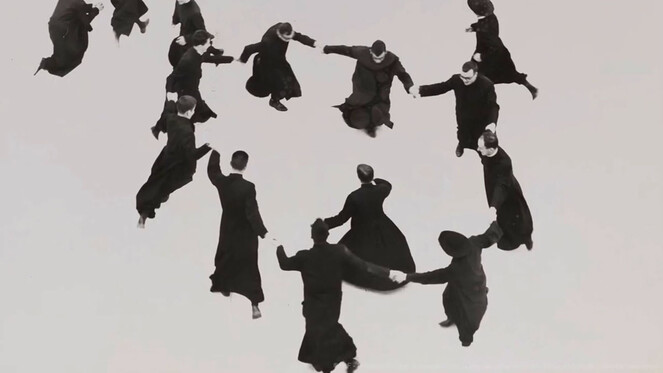
Mario Giacomelli - Pretini (Dancing Priests), Italy 1961
The BNF Richelieu is the place to be for anyone with a passion for culture and knowledge, whether French-speaking or not. It offers access to unique collections of antiquarian works, as well as exhibitions and cultural events. Its historic building and prestigious atmosphere make it a fascinating place to visit.
Bibliothèque nationale de France
5 Rue Vivienne, 75002 Paris5 Rue Vivienne, 75002 Paris
Tuesday to Sunday, 10:00 am to 6:00 pm. Nocturne on Tuesdays until 8pm.
https://www.bnf.fr/fr/richelieu
The gallery was bought by Félix Potin in 1828. Félix Potin was a Lyonnais businessman, famous for his chain of grocery stores and his innovations in retailing. This purchase marked an important turning point in the history of this emblematic space.
The gallery was a meeting place for Parisian high society, home to luxurious boutiques, tea rooms and restaurants. The Galerie Vivienne attracted the intellectuals and artists of the day. Stores offered a variety of luxury goods, from clothing and fashion accessories to interior design items.
The gallery was listed as a historic monument in 1974 and continues to be appreciated for its remarkable architecture and picturesque atmosphere. Even today, the Galerie Vivienne retains its selectivity, both in its architecture and decoration, and in the positioning of its stores.

The Lucien Legrand cellar table
Maison Legrand is both a wine merchant and a restaurateur. Founded in 1880, it flourished after the Second World War, and even more so after the 1980s, when it began to source its wines directly from selected winegrowers.


The restaurant is housed in the wine cellar. The menu is short but renewed every week. Dishes are always designed to match the wines in the selection. Dishes feature fresh, seasonal French produce.
Chef Benjamin Anthoni creates dishes of great finesse, with flavors that are sometimes exotic, sometimes indefinable.
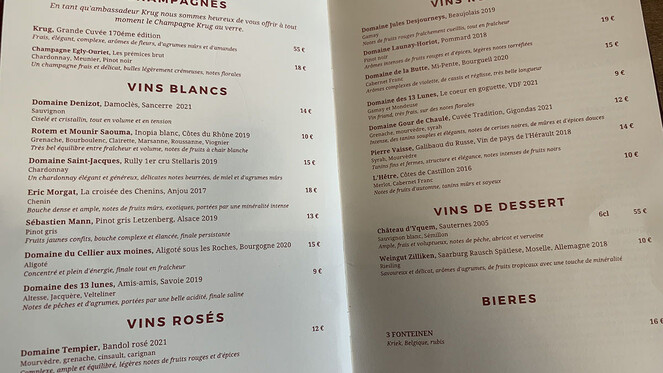

We've chosen two starters, and the host recommends an Aligoté wine from the Ferté Givry abbey, founded in 1130. What a story!
The wine has a beautiful golden color. The palate reveals aromas of white peach with a lovely saline character on the finish.

It's a fine match with this first starter: green beans in salad, ketchup and rhubarb pickles, raw cream with dill and fried shallots. Please note: this is not ketchup from a popular brand beginning with an H. Ketchup is a condiment. This is not tomato ketchup. But what kind of ketchup? Darn, I forgot and I don't have a word to describe the delicacy of this appetizer.

We continue with bouchot mussels and pan-fried cloves, butter, tarragon and ginger. The bouchot is like a wooden stake on which the mussels hang. Is it the season? Yes, late May and early June! The first porcini mushrooms also come out at this time.
The dish is magnificent in its flavors. The cloves are firm, the ginger light and the juice slightly acidic. I couldn't resist topping the dish with a very nice bread.

And then comes the apotheosis: a Panna cotta with almond milk and tonka, cherry salad with lemon thyme and buckwheat flake granola. It's a good choice, as cherries have suffered from a lack of water this year and are therefore not very sweet. So their presence doesn't overwhelm the smooth, sweet almond milk. The granola adds the crunch. A delicious treat.


In short, this address is a good choice for those looking for refined dining and expert wine pairing.
Le Comptoir et les Caves Legrand
Monday to Saturday, 10 a.m. to 11 p.m.
1 Rue de la Banque, 75002 Paris
https://www.caves-legrand.com/
La Galerie Vivienne

If you prefer Brasserie-style dining, you can choose "Le Bouginville". A café whose 70's decor has been maintained. The food is very good.


The stores, whether fashion, home or cultural products, are positioned at the top end of the market.

There's also an antiquarian bookshop offering French books, prints and posters, as well as a smaller selection of English-language books. Prices are affordable.

After your visit to the Galerie Vivienne, you can visit the jewel-like Bibliothèque nationale Richelieu, or stroll through the Palais royal (see our article).
Galerie Vivienne
http://www.galerie-vivienne.com/
The roastery of this beautiful establishment is located in the beautiful rue de Montpensier, behind the garden of the Palais Royal.
At tea time or lunch time?
The first floor room is chic and elegantly decorated. The menu offers a selection of teas and coffees as well as sweet and savory dishes (see the menu).


We ordered a caramel éclair from the Maison Stohrer, accompanied by "Chaï Verlet" tea, which is a black tea flavored with cardamom, clove and cinnamon. We are transported by these flavors that seem exotic. The blen is exquisite with the fresh cabbage and the very powerful caramel. The caramel pieces explode in your mouth. It is delicious.

You can be guided by the timer with three hourglasses: a light, strong or flavoured tea?

The upstairs room has an atmosphere that has been shaped by history.

A selection of 30 coffees and 60 high quality teas



Maison Verlet invests a lot of time and effort upstream because it is also an audacious importer with a good knowledge of rare terroirs, small unknown plots and original flavors. Maison Verlet has maintained a culture and knowledge of many planters while defending an ethical approach to production.
As a tea lover, we just bought two teas to give an example of what can be found at Verlet. They were chosen for their originality. It is indeed unusual to taste a Thai or Vietnamese tea. This choice is in line with the Verlet selection. We find teas from the best gardens, from small plantations, new and tasty tastes from exceptional producers.

Lao Cai Shan Tea: This tea is made from large-leaf tea plants, called Shan tea plants, growing in the northern regions of Vietnam. It will please green tea lovers, with cooked, slightly toasted and robust vegetal notes.
Royal Black Thai Tea : This is a tea that is hand-picked in Doi Angkhan, northern Thailand. It has long, twisted leaves with coppery highlights and woody and fruity notes.

Café Verlet
256 Rue Saint-Honoré, 75001 Paris
https://www.verlet.fr/en/
The history of the Palais Royal

The Palais Royal under Louis XIV - The Molière theater is located on the right of the main entrance. You can see in the background that the arcades have not yet been built.

Salle Richelieu, Comédie Française. The Comédie Française is an institution with a repertoire of 3500 plays, some of which are subtitled in English.

Camille Desmoulins at the Palais Royal on July 12, 1789
What to do and see at the Royal Palace?

The entrance to the Royal Palace is free.

Although they were seriously obstructed by the Chirac government, the Buren columns do not seem to leave the public unmoved today.
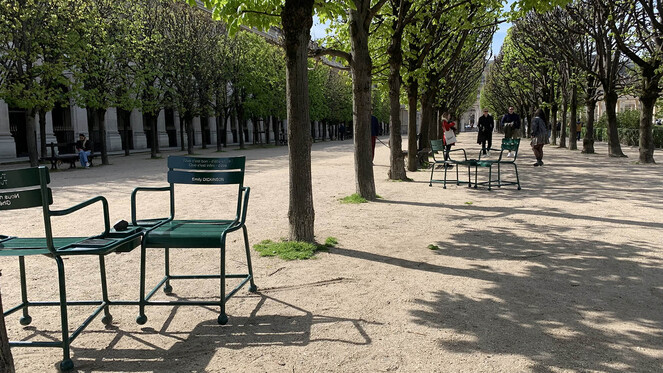
The garden offers beautiful walkways and plenty of seating that will be welcome after a walk or jog.

The walker can take advantage of numerous recreational areas



You will find several establishments offering pleasant terraces.


Several restaurants are present, including the Palais Royal restaurant and the Grand Véfour, which are among the most prestigious restaurants in Paris.

The galleries designed by Louis-Philippe d'Orléans house selective and sometimes atypical shops.
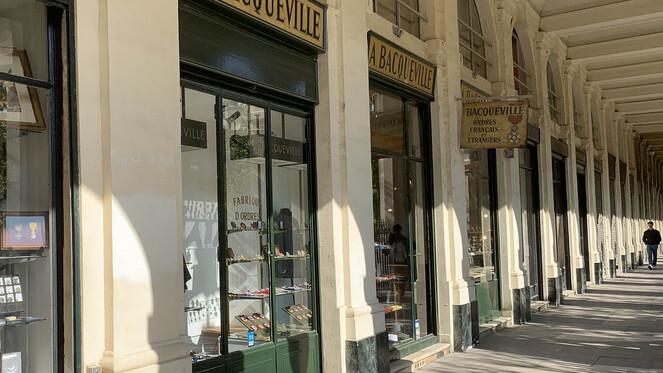
The Bacqueville store manufactures and distributes signs of distinction and medals for town halls and ministries in France and abroad since 1790.

"Les Drapeaux de France" is a store that offers old fashioned figurines.

Mr. Roussel, the owner, estimates his stock at over 100,000 pieces. Such a stock would make this store one of the most important in the world in its category.



There are also several designers and art galleries.

By leaving the Palais Royal by the north, we reach the rue de Beaujolais then the rue de Montpensier. A very picturesque district!

The Theatre du Palais Royal, rue de Montpensier, is part of the real estate program of Louis Philippe d'Orléans. This theater was initially intended to present puppet shows.
Palais Royal
Free admission
- October 1 - March 31: 7:30am - 8:30pm
- April 1 - May 31: 7am - 10pm
- June 1 - August 31: 7am - 11pm
- September 1 - September 30: 7:00am - 9:30pm
Photo credit: Coach Hotels except (The Palais Royal under Louis XIV, Camille Desmoulins at the Palais Royal, Salle Richelieu Comédie Française, copyright free)
For more than 25 years, Thomas Demand has been photographing his sculptures, real paintings that appear to represent a real world. His stagings, which he makes ephemeral by destroying them after having photographed them, are often inspired by media facts. The objects he works on are made of paper. A paper that he forms, manipulates, articulates in narrative decor.
Without wanting to reveal the exhibition, here are some paintings that have caught our attention.
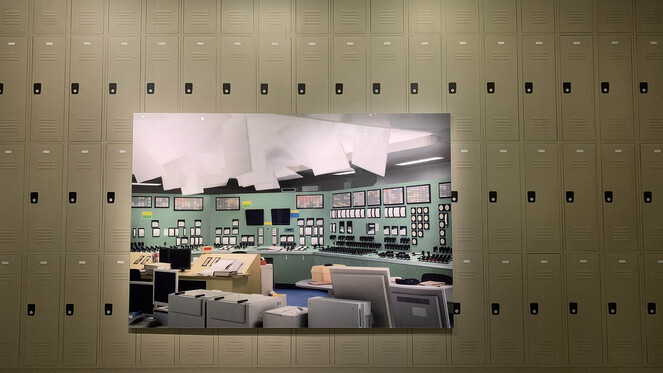
Das Kontrollraum - 2011
This improbable space where paper rubs shoulders with the digital world, is singled out by the absence of presence but not of human trace, as is often the case in his works where the narration is given by the decor. This scene is inspired by a photo taken by a technician of the Fukushima Daiishi power plant in the control room of reactor No. 1 after the earthquake and tsunami that devastated the plant.

Studio – 1997

Lictung – 2003

Werkstatt - 2017
Everything is paper in this totally fictitious luthier's workshop. Below is the study we discovered on Thomas Demand's website.



Grotte – 2006
Thomas Demand used 36 tons of cardboard to build this cave to scale one, before keeping only the photographs. What the artist wishes to highlight is that the hand of nature, which forms century after century its decor so majestic and sophisticated, is reduced to the status of an object of "Instagram" post.
Only the model of this work has been preserved. All the others have been destroyed.

Pond – 2020
This photograph of a water and paper setting is reminiscent of Claude Monet's Water Lilies.
In addition to a majority of large formats, the exhibition unveils about fifteen smaller formats made from photos taken by Thomas Demand with his telephone. One is struck by the particularly picturesque transcription and the poetry of certain views.

Le musée du Jeu de Paume signe encore une fois une très belle exposition d’un artiste aux œuvres à la fois personnelles dans leur message, spectaculaires dans leur fabrication et esthétiques dans leur mise en scène. Tout cela est magistralement mis en scène. Courrez-y !
The Jeu de Paume museum once again signs a very beautiful exhibition of an artist whose works are at once personal in their message, spectacular in their production and aesthetic in their staging. All this is masterfully staged. Run there!
Thomas Demand - Le Bégaiement de l’histoire - until May 28, 2023
1 Pl. de la Concorde, 75008 Paris
Tuesday to Sunday from 11:00 am to 7:00 pm. Nocturne on tuesday until 21h00
https://jeudepaume.org/evenement/exposition-thomas-demand/
https://thomasdemand.net/selected-work
This restaurant is located rue Sainte-Anne, in a district well known for its concentration of Japanese restaurants.

There are three specialties in this restaurant: ramen, gyozas and Chukado
Ramens or Lamen: This soup, now well known by Westerners, arrived in Japan in the 19th century. It is a broth garnished with chopped spring onion, roasted pork, soft egg, and bamboo shoots. It is pronounced Ramen or Lamen because the Japanese do not make a difference between the L and the R.

Ramens
Gyozas: These are grilled ravioli. Gyoza is a descendant of jiaozi, which is a Pekinese ravioli. Gyozas consist of a wheat-based dough shell sealed around a pork and vegetable filling. The ravioli is fried on one side, then sprinkled with water and cornstarch and covered for a few minutes. The gyozas are served with the toasted side up, but since we didn't know that at the time of tasting, we naively turned the ravioli upside down for the photo.

It's fresh and crispy. We enjoyed them with a hot sauce.
Finally, the last specialty, Chukadon. It is a popular dish in Japan, a stir-fry dish made from pasta, bean sprouts, onions, mushrooms and thin slices of pork. This dish is also inspired by Chinese cuisine. The dish is well done although a little bit heavy/fat, as it is sometimes the case in Chinese cuisine. We accompanied it with a glass of hot sake which is very good in winter, to warm up.

The dining room is simple but what is appreciable as in many Japanese restaurants, is to eat at the bar, in front of the cooks.
Higuma will prove to be a good choice for a family meal, for lunch or dinner before a show. It's good, fast, simple and economical.

Higuma
32 Bis Rue Saint-Anne - 75001 Paris
Tous les jours de 11h30 à 22h00
http://higuma.fr/
On sunny days, you can enjoy one of the most beautiful restaurant terraces in the city. It is beautiful, it is good, it is calm. Today, in the middle of winter, we are going to stay in the room, well warm.




Since last summer, the chef is Adrien Bernier. This self-taught chef particularly likes to cook seafood, but also meat grilled over a wood fire. That's why my choice is going to be a starter based on shellfish followed by a grill. We start with roasted langoustines, crispy vegetables and langoustine broth with Asian lemon.

The langoustines are very fresh, which is the condition for this crustacean to have taste. The broth is truly exquisite. Good products for a simple and authentic dish with a real flavor. We accompanied it with a Quincy Domaine Grand Rosières. The Quincy is still a Sauvignon grape. It is a beautiful agreement with these scampi with Asian lemon by the fruity notes and even of exotic citrus fruits that this wine brings.
We follow with a Black Angus beef flank steak from Creekstone Farm.
The Angus or Aberdeen Angus is a Scottish cattle breed. The Angus are raised in the open air and feed on pastures. This meat is distinguished by its marbling with grassy notes and contrary to appearances, this breed is characterized by very docile and calm animals. Black Angus is one of the most exceptional meats. The breed has been exported to America and Australia.
By visiting the website of the Creekstone farm I learn that it is located in Kansas. If the quality of the Scottish Black Angus is equivalent to that of its American cousin, why didn't they choose a shorter route?
Let's try to relieve our guilt and taste this little meaty treasure that is served with mashed potatoes.


It is also copious and one could almost share this dish with a Côtes du Rhône "Le temps est venu", which gives off woody notes. Beautiful agreement again.
We then continue with an apple pie "Grandma" topped with vanilla ice cream. The pie is mounted on a shortbread and toasted, which caramelizes its topping. The texture of the pastry lacks a bit of firmness and is slightly moistened, probably not because of its lack of freshness but more because of the particularly humid weather we endure. A set-up that could also have gained in hold but the taste is nevertheless particularly appealing.
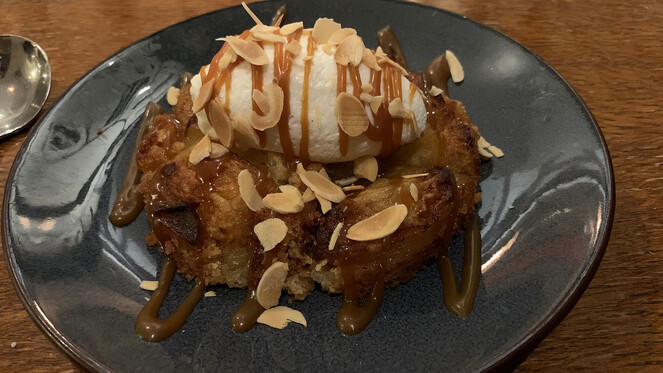
Then came the moment of the small attraction. The absinthe does not steal its name since it proposes a card of about sixty absinthes coming from about fifteen distilleries.
This alcohol which is between 45° and 90° and whose origin is uncertain was promoted by Henri Louis Pernod, whose name is now popular for the anisette Pernod Ricard. Absinthe was consumed by the French soldiers who colonized Algeria, in particular to get over the inconvenience of malaria and dysentery. Relatively expensive at the beginning of its production, it became so popular that very poor quality absinthes were developed so much so that a glass of absinthe was worth less than a glass of wine in 1910, which encouraged the development of a sometimes devastating alcoholism as described in L'Assommoir, and contributed to finally voting its prohibition in 1915 after having been the vector of vivid campaigns with repulsive objectives. "Absinthe makes you crazy", they said. It was reinstated in 1988 and then produced again in 1999.
Let's try this absinthe. It is poured into a special glass on which is placed an absinthe spoon containing a sugar. A fountain pours an iced water drop by drop on this sugar. The alcohol is more bitter than anisette, less sweet, more vegetal and like anisette, long in the mouth. It finishes this exceptional meal pleasantly.
We are served diligently, well received by Mr. Philippe, who we will listen to on the subject of absinthe with interest. We only regret that the restaurant is closed on weekends.

L'Absinthe
24, place du Marché Saint-Honoré - Paris 1er
De 12h00 à 14h15 et de 19h à 22h15du lundi au vendredi
http://www.restaurantabsinthe.com/
We inform you that due to the current sanitary situation, the breakfast is served only in the room.
Many thanks in advance for your understanding.
All the Relais Saint Honore’s team sincerely do hope first that, — in spite of the global lockdown the world has lately faced —, our present Newsletter finds each of you safe, as also your relatives and friends.
Of course, — for everyone’s safety —, all sanitary measures will be strictly observed, from the front desk of the hotel to the rooms, as mentioned on our official website.
Some of you know, or even stayed, in our Grande Suite #502, located at the 5th of the hotel, and which is often requested on account of its romantic tone. We are happy to inform you that the fabrics of this Suite has been totally changed, which makes this room now even brighter, than it was already initially.
But, as above-mentioned, our most exciting news is the creation of a brand new Family Suite of 48m² ! Maximum people occupancy will be 5. This huge Suite will be configured with a bedroom part, plus its own bathroom, and a lounge part with a second bathroom.
Ideally located at the ground floor, no more nor less comfort and quiet will be offered to you !
As speaking of reservation process, we inform you, — or remind you —, that booking directly with the hotel, (by mail, telephone or on official web site), always remains the cheapest, the easiest, — and, let’s admit it —, the warmest way to book a room with us!
In spite of the rough time we all have gone through lately, we have intensified our efforts to make the reopening of the Relais Saint Honoré a moment of happy and memorable reunion.
Do take very good care of yourselves, and have a lovely summertime !
Our warmest regards on behalf of all the Relais Saint Honoré’s team.
Exceptional cuisine, an extraordinary setting, a historic palace, and a world-class chef. These are the ingredients that make up this exceptional restaurant, which is a 10-minute walk from the Relais Saint-Honoré.
 Photo credit Jérôme Mondière
Photo credit Jérôme Mondière
History
The restaurant opened in 1784, back then known as Café de Chartres. The decor has remained unchanged ever since, despite the revolutions and wars that the establishment has undergone.
 Napoleon Bonaparte, Mac Mahon, and Georges Sand have sat on its benches. Victor Hugo had his napkin and his regular dish, which never changed: vermicelli, mutton breast, and white beans.
Napoleon Bonaparte, Mac Mahon, and Georges Sand have sat on its benches. Victor Hugo had his napkin and his regular dish, which never changed: vermicelli, mutton breast, and white beans.
Jean Cocteau also became a loyal customer of the restaurant and would even draw there (menu opposite). The rooms also have several of the artist's drawings. Jean Marais, Sacha Guitry, Colette, who stayed above the restaurant, André Malraux, Louis Aragon, Jean-Paul Sartre, and Simone de Beauvoir also regularly came to Le Grand Véfour.
Decor or a Time Machine?
The decor borrows from styles such as Rococo and Transition, and will immerse you in the mood of good taste that the nobility and the bourgeoisie of the time appreciated. It's hard not to be impressed when you walk through the front door.

The Chef
 Guy Martin is ranked by the World Master Arts of Culinary as on of the seven best chefs in the world. He has received countless distinctions and awards. He is also the author of many books, making him probably one of the most productive chefs. This self-taught Savoyard started in the business at 17 as a pizzaiolo. Le Grand Véfour received its first Michelin star only 6 months after its arrival in 1985, 28 years ago. Le Grand Véfour got its 2nd star in 1995 and its 3rd star five years later, which it kept uptil 2008.
Guy Martin is ranked by the World Master Arts of Culinary as on of the seven best chefs in the world. He has received countless distinctions and awards. He is also the author of many books, making him probably one of the most productive chefs. This self-taught Savoyard started in the business at 17 as a pizzaiolo. Le Grand Véfour received its first Michelin star only 6 months after its arrival in 1985, 28 years ago. Le Grand Véfour got its 2nd star in 1995 and its 3rd star five years later, which it kept uptil 2008.The Menu
But how expensive is this high flying gastronomic restaurant? The lunch menu, including an appetizer, a main course, and a dessert is €155 and the tasting menu, served in the evening, is €315.For example, you can taste the foie gras ravioli with truffled cream (€98), one of Guy Martin's signature dish, which has been on the menu since 1985. It represents his "contemporary" cuisine, made of noble products, worked with richness and indulgence, inspired by his travels.
 Foie gras ravioli with truffled cream (€98)
Foie gras ravioli with truffled cream (€98)
There is the Blue lobster, with colored tomatoes and water, olive oil from la Fare les Oliviers and black salt (€118), served warm. It is a subtle range of summer flavors. Then there is also Guy Martin's other mythical dish: the oxtail parmentier with truffles (€112)

To conclude this high-flying menu, you can choose the dark chocolate Manjari cube with 64% cocoa, filled with oranges and pomegranates, whose acidity is softened by a sorbet and a coconut biscuit. The waiter told us to hit the cube with the back of the spoon in order to begin eating without making to much noise. We owe this desert to Mourad Rachdi, the pastry chef of Le Grand Véfour, it is as gourmet as it is pretty.
Enjoy!

Manjari Cube, raspberries with lemongrass and tarragon, shortbread with oat flakes (€40)
GRAND VÉFOUR
17, rue de Beaujolais - 75001 Paris
Monday to Friday, from 12:30 pm to 2:00 pm and from 8:00 pm to 10:00 pm
Tel. 01 42 96 56 27
http://www.grand-vefour.com/en/

Its Belle Epoque decoration by Edouard-Jean Niermans (Hotel Negresco - The Moulin Rouge) is rich in frescoes, mirrors, marbles, moldings and gilding, tapestries, and porcelain services...
Marcel Proust frequented the tea house. Coco Chanel, who lived next door at the Ritz, had a soft spot for hot chocolate and also came here. After her, there was Audrey Hepburn, Serge Gainsbourg, and others.

 Sébastien Bauer is the tea house's head pastry chef. This thirty-year-old already has a brilliant career behind him: he was a pastry chef at the Ritz and the Bristol before becoming the creative director alongside Pierre Hermé.
Sébastien Bauer is the tea house's head pastry chef. This thirty-year-old already has a brilliant career behind him: he was a pastry chef at the Ritz and the Bristol before becoming the creative director alongside Pierre Hermé.Our first tip is to visit Angelina preferably during the week. You will avoid waiting in line at the entrance; however, the line does move quickly. Nonetheless, expect a slight wait.
Angélina is particularly known for its hot chocolate and Mont Blanc. To come to Angélina and miss these two mainstays of the house would be a shame.
The hot chocolate, called "l'Africain" (€8.20), is an old-fashioned hot chocolate composed of three cocoas originating from different areas of Africa: Niger, Ghana, and Côte d’Ivoire. Thick chocolate is served in a porcelain pitcher with a dish of whipped cream. It is reputed to be among the best in Paris.

Mont-Blanc is the other must at Angélina. It is composed of a base in meringue, a light whipped cream, and topped with Ardèche chesnut cream vermicelli (€9.20). The cream is dense and not too sweet, which allows it to develop a strong chestnut flavor reminiscent of candied chesnuts.

Paris-New York and Mont Blanc
The sufficiently sweet meringue is crisp and crumbly even at its center. The whipped cream is very light and not too sweet. Mont Blanc lovers will appreciate this wonderfully done cake. done.
You will also be tempted by the Paris-New York. This is a revisited version of Paris-Brest made of a choux pastry, a praline cream with pecans, and a center made of crunchy pecan praline (€ 9.00).

Angélina offers a € 39 brunch consisting of a hot drink, fresh-squeezed fruit juice or a fruit cocktail, mini pastries and Moisan organic bakery rolls, a main dish and a dessert of your choice, and a glass of champagne.


La brioche perdue served with the Brunch
Eating "on the go" is possible every day from 11:45 until 18:30 with club sandwiches, croque-monsieur or croque-madame, quiches, and omelettes. Priced from €16 to €27.
Finally, at the delicatessen, you will find hot chocolate, chestnut cream, teas, cookies, spreads, chocolate bars, chocolate praline truffles, chocolate-covered almonds and coffee beans, and other delicacies...

ANGELINA PARIS
226 Rue de Rivoli, 75001 Paris
Monday to Friday from 7:30 am to 7 pm - Saturday and Sunday from 8:30 am to 7:30 pm
http://www.angelina-paris.fr/fr/content/8-le-salon-de-the

La décoration intérieure, confiée à l’architecte Christophe Tollemer, est contemporaine et élégante mais plus classique et intimiste dans les salons privés.


 Philip Chronopoulos, le Modigliani des fourneaux de ces lieux, est un Athénien trentenaire formé à l’institut Paul Bocuse. Après avoir participé à l’ouverture de l’Atelier Robuchon de Londres, il rejoint l’équipe d’Alain Passard à L’Arpège (3 étoiles au Michelin) puis de nouveau Joël Robuchon aux laboratoires où sont créés les plats des restaurants du groupe, et puis participe au lancement de L’Atelier Robuchon Etoile. C’est enfin en 2015 que Philip Chronopoulos arrive au Restaurant du Palais Royal pour y créer une cuisine française aux influences méditerranéennes.
Philip Chronopoulos, le Modigliani des fourneaux de ces lieux, est un Athénien trentenaire formé à l’institut Paul Bocuse. Après avoir participé à l’ouverture de l’Atelier Robuchon de Londres, il rejoint l’équipe d’Alain Passard à L’Arpège (3 étoiles au Michelin) puis de nouveau Joël Robuchon aux laboratoires où sont créés les plats des restaurants du groupe, et puis participe au lancement de L’Atelier Robuchon Etoile. C’est enfin en 2015 que Philip Chronopoulos arrive au Restaurant du Palais Royal pour y créer une cuisine française aux influences méditerranéennes.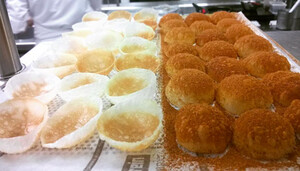 La carte offre un menu déjeuner à 55€ avec une entrée, 4 plats au choix et deux desserts au choix. Il vous sera notamment servi « L’œuf de mon enfance », classique de la carte, qui est l’œuf à la tomate du grand-père du chef : Une pâte à raviole soufflée qui renferme en son cœur un jaune d’œuf coulant sur une sauce tomate au miel de bruyère et aux épices cajun. La carte propose des entrées entre 34€ et 56€, des plats entre 48€ et 88€ et des desserts entre 19 et 25€.
La carte offre un menu déjeuner à 55€ avec une entrée, 4 plats au choix et deux desserts au choix. Il vous sera notamment servi « L’œuf de mon enfance », classique de la carte, qui est l’œuf à la tomate du grand-père du chef : Une pâte à raviole soufflée qui renferme en son cœur un jaune d’œuf coulant sur une sauce tomate au miel de bruyère et aux épices cajun. La carte propose des entrées entre 34€ et 56€, des plats entre 48€ et 88€ et des desserts entre 19 et 25€.Vous pourrez goûter les « Herbes lactées, châtaignes confites au Château Chalon et noix » (42€) : Une tartelette en brick avec des morceaux de châtaignes et de champignons accompagnés d’une mousse de fromage de chèvre et herbes fraîches, relevés d’un jus de pois chiche. C'est à la fois craquant par la tartelette, léger et fondant par la mousse alors que les châtaignes et champignons apportent la mâche. Superbe.

Herbes lactées, châtaignes confites au Château Chalon et noix
Le « Poulpe au piment fumé, pommes grenaille caramélisées » (42€), est quant à lui un poulpe rôti accompagné d’une brunoise de céleri et citron jaune, de pommes grenaille, de piquillos et salicornes en tempura, du cresson et de la poudre d'ail frit le tout sur une crème de piment fumé.

Poulpe au piment fumé, pommes grenaille caramélisées
Enfin, la « Noix de Saint-Jacques, potimarron à l’amande et truffe noire » (88€) est servie sur une tombée de chou vert agrémentée d’un jus de coquillage au vin jaune. Quelques gnocchis apportent le moelleux. C’est excellent.

Et si vous aspirez à faire léviter vos sens, vous pourrez retrouver ces plats dans un menu gastronomique 7 services où les assiettes se montrent toutes auxquelles les plus taquinantes pour les papille comme ce Saint Pierre de ligne asperges blanches et gnocchi de carottes au gingembre et ce Carré de porcelet grillé girolles et aromes café :


RESTAURANT DU PALAIS ROYAL
110 Galerie de Valois - 75001 Paris
Du mardi au samedi de 12h à 14h30 et de 19h à 22H30
Tél. : +33 (0)1 40 20 00 27
www.restaurantdupalaisroyal.com



